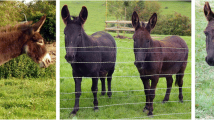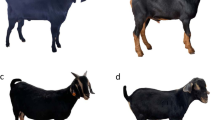Abstract
The agouti-signaling protein (ASIP) plays a major role in mammalian pigmentation as an antagonist to melanocortin-1 receptor gene to stimulate pheomelanin synthesis, a major pigment conferring mammalian coat color. We sequenced a 352 bp fragment of ASIP gene spanning part of exon 2 and part of intron 2 in 215 animals representing six goat breeds from Nigeria and the United States: West African Dwarf, predominantly black; Red Sokoto, mostly red; and Sahel, mostly white from Nigeria; black and white Alpine, brown and white Spanish and white Saanen from the US. Twenty haplotypes from nine mutations representing three intronic, one silent and five missense (p.S19R, p.N35K, p.L36V, p.M42L and p.L45W) mutations were identified in Nigerian goats. Approximately 89 % of Nigerian goats carry haplotype 1 (TGCCATCCG) which seems to be the wild type configuration of mutations in this region of the gene. Although we found no association between these polymorphisms in the ASIP gene and coat color in Nigerian goats, in-silico functional analysis predicts putative deleterious functional impact of the p.L45W mutation on the basic amino-terminal domain of ASIP. In the American goats, two intronic mutations, g.293G>A and g.327C>A, were identified in the Alpine breed, although the g.293G>A mutation is common to American and Nigerian goat populations. All Sannen and Sahel goats in this study belong to haplotypes 1 of both populations which seem to be the wild-type composite ASIP haplotype. Overall, there was no clear association of this portion of the ASIP gene interrogated in this study with coat color variation. Therefore, additional genomic analyses of promoter sequence, the entire coding and non-coding regions of the ASIP gene will be required to obtain a definite conclusion.





Similar content being viewed by others
References
Becerril CM, Wilcox CJ, Lawlor TJ et al (1993) Effects of percentage of white coat color on Holstein’s production and reproduction in a subtropical environment. J Dairy Sci 73:2286–2291
Acharya RM, Gupta UD, Sehgal JP, Singh M (1995) Coat characteristics of goats in relation to heat tolerance in the hot tropics. Small Rumin Res 18:245–248
Singh K, Singh D, Kumar P (1997) Dark coat color in Indian desert goats as an adaptation mechanism to economize feed energy in cool period. Z Ernahrungswiss 36:324
Norris BJ, Whan VA (2009) A gene duplication affecting expression of the ovine ASIP gene is responsible for white and black sheep. Genome Res 18:1282–1293
Costin GE, Hearing VJ (2007) Human skin pigmentation: melanocytes modulate skin color in response to stress. FASEB J 21:976–994
Deng WD, Xi DM, Gou X et al (2009) Pigmentation in black-boned sheep (Ovis aries): association with polymorphism of the tyrosinase gene. Mol Biol Rep 35:379–385
Scott MC, Wakamatsu K, Ito S et al (2002) Human melanocortin 1 receptor variants, receptor function and melanocyte response to UV radiation. J Cell Sci 115:2349–2355
Robbins LS, Nadeau JH, Johnson KR et al (1993) Pigmentation phenotypes of variant extension locus alleles result from point mutations that alter MSH receptor function. Cell 72:827–834
Keifer LL, Ittoop ORR, Bunce K, Truesdale AT, Willard DH, Nichols JS, Blanchard SG, Mountjoy K, Chen W-J, Wilkison WO (1997) Mutations in the carboxyl terminus of the agouti protein decrease agouti inhibition of ligand bind to melanocortin receptors. Biochemistry 36:2084–2090
Bultman SJ, Michaud EJ, Woychik RP (1992) Molecular characterization of the mouse agouti locus. Cell 71(7):1195–1204
Fontanesi L, Beretti F, Riggio V, González EG, Dall’Olio S, Davoli R, Russo V, Portolano B (2009) Copy number variation and missense mutations of the agouti signaling protein (ASIP) gene in goat breeds with different coat colors. Cytogenet Genome Res 126:333–347
Blench R (1999) Traditional livestock breeds: geographical distribution and dynamics in relation to the ecology of West Africa. Working Paper 122. Overseas Development Institute, London
Yakubu A, Salako AE, Imumorin IG (2011) Comparative multivariate analysis of biometric traits of West African Dwarf and Red Sokoto goats. Trop Anim Health Prod 43:561–566
Yakubu A, Raji AO, Omeje JN (2010) Genetic and phenotypic differentiation of qualitative traits in Nigerian indigenous goat and sheep populations. ARPN J Agric Biol Sci 5(2):58–66
Wilson RT (1991) Small ruminant production and the small ruminant genetic resource in tropical Africa. FAO Animal Production and Health Paper, 88
Mohammed ID, Amin JD (1996) Estimating body weight from morphometric measurements of Sahel (Borno White) goats. Small Rumin Res 24:1–5
Rozas J, Sanchez-DelBarrio JC, Messeguer X, Rozas R (2003) DnaSP, DNA polymorphism analyses by the coalescent and other methods. Bioinformatics 19:2496–2497
Tajima F (1989) Statistical method for testing the neutral mutation hypothesis by DNA polymorphism. Genetics 123:585–595
Raymond F (2008) Genepop’007: a complete reimplementation of the Genepop software for Windows and Linux. Mol Ecol Res 8:103–106
Tamura K, Petersen D, Petersen N, Stecher G, Nei M, Kumar S (2011) MEGA 5: molecular evolutionary genetics analysis using maximum likelihood evolutionary distance and maximum parsimony methods. Mol Biol Evol 28:2731–2739
Thomas PD, Campbell MJ, Kejariwal A et al (2003) PANTHER: a library of protein families and subfamilies indexed by function. Genome Res 13:2129–2141
Brunham LR, Singaraja RR, Pape TD, Kejariwal A, Thomas PD, Hayden MR (2005) Accurate prediction of the functional significance of single nucleotide polymorphisms and mutations in the ABCAI gene. PLoS Genet 1:e83
Bandelt HJ, Forster P, Rohl A (1999) Median-joining networks for inferring intraspecific phylogenies. Mol Biol Evol 16:37–48
Suharyanto, Shiraishi S (2011) Nucleotide diversities and genetic relationship in three Japanese pine species; Pinus thunbergii, Pinus densiflora, and Pinus luchuensis. Diversity 3:121–135
Strobeck C (1983) Expected linkage disequilibrium for a neutral locus linked to a chromosomal arrangement. Genetics 103:545–555
Hudson RR, Kaplan NL (1988) The coalescent process in models with selection and recombination. Genetics 120:831–840
Kaplan NL, Daren T, Hudson RR (1988) The coalescent process in models with selection. Genetics 120:819–829
Miné M, Brivet M, Touati G, Grabowsk P, Abitbol M, Marsac C (2003) Splicing error in E1α pyruvate dehydrogenase mRNA caused by novel intronic mutation responsible for lactic acidosis and mental retardation. J Biol Chem 278(14):11768–11772
Holla ØL, Nakken S, Mattingsdal M, Ranheim T, Berge KE, Defesche JC, Leren TP (2009) Effects of intronic mutations in the LDLR gene on pre-mRNA splicing: comparison of wet-lab and bioinformatics analyses. Mol Genet Metab 96(4):245–252
Nascimbeni AC, Fanin M, Tasca E, Angelini (2010) Transcriptional and translational effects of intronic CAPN3 gene mutations. Hum Mutat 31:E1658–E1669
Marklund S, Kijas J, Rodriguez-Martinez H, Rönnstrand L, Funa K, Moller M, Lange D, Edfors-Lilja I, Andersson L (1998) Molecular basis for the dominant white phenotype in the domestic pig. Genome Res 8:826–833
Pielberg G, Olsson C, Syvänen AC, Andersson L (2002) Unexpectedly high allelic diversity at the KIT locus causing dominant white color in the domestic pig. Genetics 160:305–311
McNulty JC, Jackson PJ, Thompson DA, Chai B, Gantz I, Barsh GS, Dawson PE, Millhauser GL (2005) Structures of the agouti signaling protein. J Mol Biol 346:1059–1070
Jackson PJ, Douglas NR, Chai B, Binkley J, Sidow A, Barsh GS, Millhauser GL (2006) Structural and molecular evolutionary analysis of agouti and agouti-related proteins. Chem Biol 13(12):1297–1305
Schioth HB, Petersson S, Muceniece R, Szardenings M, Wikberg JE (1997) Deletions of the N-terminal regions of the human melanocortin receptors. FEBS Lett 410:223–228
Arnold A, Horst SA, Gardella TJ, Baba H, Levine MA, Kronenberg HM (1990) Mutation of the signal peptide-encoding region of the preproparathyroid hormone gene in familial isolated hypoparathyroidism. J Clin Investig 86(4):1084–1087
Ito M, Oiso Y, Murase T, Kondo K, Saito H, Chinzei T, Racchi M, Lively MO (1993) Possible involvement of inefficient cleavage of preprovasopressin by signal peptidase as a cause for familial central diabetes insipidus. J Clin Investig 91(6):2565–2571
Searle AG (1968) Comparative genetics of coat color in mammals. Logos Press, London
Adalsteinsson S, Sponenberg DP, Alexieva S, Russel AJF (1994) Inheritance of goat coat colors. J Hered 85:267–272
Miltenberger RJ, Wakumatsu K, Ito S, Woychik RP, Russell LB, Michaud EJ (2002) Molecular and phenotypic analysis of 25 recessive, homozygous-viable alleles at the mouse agouti locus. Genetics 160:659–674
Kanetsky PA, Swoyer J, Panossian S, Holmes R, Guerry D, Rebbeck TR (2002) A polymorphism in the agouti signaling protein gene is associated with human pigmentation. Am J Hum Genet 70:770–775
Girardot M, Guibert S, Laforet MP, Gallard Y, Larroque H, Oulmouden A (2006) The insertion of a full-length Bos taurus LINE element is responsible for a transcriptional deregulation of the Normanne Agouti gene. Pigment Cell Res 19:346–355
Kuramoto T, Nomato T, Sugimura T, Ushijima T (2001) Cloning of the rat agouti gene and identification of the rat nonagouti mutation. Mamm Genome 12:469–471
Rieder S, Taourit S, Mariat D, Langlois B, Guérin G (2001) Mutations in the agouti (ASIP), the extension (MC1R), and the brown (TYRP1) loci and their association to coat color phenotypes in horses (Equus caballus). Mamm Genome 12(6):450–455
Royo LJ, Álvarez I, Arranz JJ, Fernández I, Rodríguez A et al (2008) Differences in the expression of the ASIP gene are involved in the recessive black coat color pattern in sheep: evidence from the rare Xalda sheep breed. Anim Genet 39:290–293
Fontanesi L, Beretti F, Riggio V, Dall’Olio S, González EG, Finocchiaro R, Davoli R, Russo V, Portolano B (2009) Missense and nonsense mutations in melanocortin 1 receptor (MC1R) gene of different goat breeds: association with red and black coat color phenotypes but with unexpected evidences. BMC Genet 10:47
Acknowledgments
Financial support from College of Agriculture and Life Sciences, Cornell University is gratefully acknowledged. Special thanks to Dr. W. Ron Butler, the Department of Animal Science and College of Agriculture and Life Sciences at Cornell University for the opportunity given to M.A.A. and B.O.A. as visiting research students at Cornell University.
Author information
Authors and Affiliations
Corresponding author
Rights and permissions
About this article
Cite this article
Adefenwa, M.A., Peters, S.O., Agaviezor, B.O. et al. Identification of single nucleotide polymorphisms in the agouti signaling protein (ASIP) gene in some goat breeds in tropical and temperate climates. Mol Biol Rep 40, 4447–4457 (2013). https://doi.org/10.1007/s11033-013-2535-1
Received:
Accepted:
Published:
Issue Date:
DOI: https://doi.org/10.1007/s11033-013-2535-1




